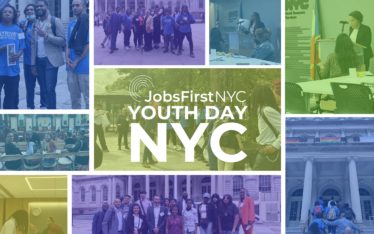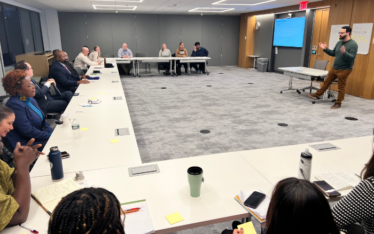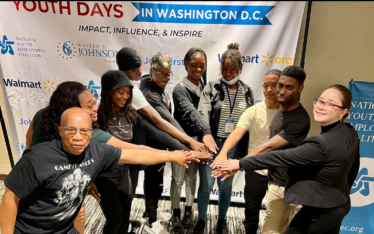In a recent blog published on Sept 3, 2020, JobsFirstNYC posed the question: With an estimated 27 percent (259,000) to 34 percent (324,000) of NYC Young Adults out of school and out of work, what’s the city’s plan?
The city recently announced that it is proposing to cut programs in transfer schools by 72 percent, which threatens to immediately devastate more than 15,000 young adult New Yorkers who are over-age, undercredited, and off-track to graduate. This reckless move would also threaten to bring New York City’s graduation rate back to the dark ages as transfer high schools, Young Adult Borough Centers, and other important investments are driving factors to why the city’s high school graduation rate went from 54 percent in 2004 to now 80 percent.
Students enroll in transfer high schools because they face significant barriers to graduation and the traditional education system has failed to adequately support their needs. There are 46 transfer high schools across New York City that serve over-age, under-credited students who are off-track to graduate and most at risk of becoming out-of-school, out-of-work. With funding provided by the NYC Department of Education through the Learning to Work contract, each school has a non-profit partner embedded into their operation to provide critical social emotional learning, wrap around support services, and stipends for internships. The small school design is focused on student engagement and retention centered around building strong relationships with caring adults who can coach them through graduation and support their transition into postsecondary education. In fact, transfer high schools have a graduation rate twice that of traditional high schools for students who are over-age and undercredited.
Career readiness and seamless transitions to postsecondary pathways for these students is more essential now than it ever has been. With high unemployment and an unprecedented economic recession, New York City’s labor market is highly competitive. We have learned from past economic downturns that young adults are typically at the back of the line when it comes to accessing economic opportunities. This is particularly true considering that 18-24 year olds represent a quarter of all low-wage workers, most of whom have been hit hardest by the COVID-19 pandemic. For the most vulnerable young adults, the situation is even more dire as more than half of those young adults working in low-wage jobs lack the necessary training and postsecondary credentials to compete in today’s increasingly skilled workforce. Now is the time for more, not less investment in rising generations.
It’s time to double down and declare career readiness and early access to postsecondary pathways as essential. The Transfer 2 Career Collaborative, an innovative pilot project led by JobsFirstNYC and New Visions for Public Schools, is focused on building partnerships between 12 transfer high schools and a set of youth serving workforce development organizations and community colleges to improve career readiness and build postsecondary pathways for students. The ultimate goal is to increase workforce and employment outcomes as a strategy to stem-the-inflow of young adults leaving the K-12 system and becoming out-of-school and out-of-work. This strategy to bring together schools and workforce development depends on the critical infrastructure of transfer high schools and their Learning to Work partners that provides critical wrap around support, social emotional learning, and paid internship opportunities.
With an estimated 259,000 to 324,000 16-24 year olds already out of work and out of school, what is the city’s plan to intervene so young adults stay engaged in an effort to prevent them from becoming disconnected? Mayor de Blasio’s Disconnected Youth Task Force is expected to release a report soon outlining the city’s plan to address the full needs of this population. Any such plan must include measurable goals and real investment that reflect the severity of the economic crisis brought on by the global pandemic. Not cuts. With limited economic opportunities, high unemployment, and increased insecurity, young adults face greater barriers than ever before.
That’s why JobsFirstNYC is calling on you to join the Learning to Work Coalition for a series of virtual rallies organized by borough! Register Here.
- Oct. 20 at 4pm – Queens (Hosts: Queens Community House and The Child Center of NY)
- Oct. 22 at 4pm – Bronx (Hosts: Good Shepherd Services and SCO Family of Services)
- Oct. 27 at 4pm – Staten Island (Host: NYCID)
Read more:
With an Estimated 27-34 Percent of NYC Young Adults Out of School and Out of Work, What’s the City’s Plan? – A blog from JobsFirstNYC calling on mayoral leadership to invest in New York City’s most vulnerable young adults
As Unemployment and Crime Spike, City Plan for Disconnected Young Adults Remans Years Behind Schedule – An article highlighting JobsFirstNYC’s concern regarding the delay in the Mayor’s Disconnected Youth Task Force in the midst of a pandemic
The Early Impact of COVID-19 on Young Adult Workforce Development: Insights from the Field – A JobsFirstNYC working paper on the impact that COVID-19 is having on workforce development practitioners
Coronavirus Threatens to Perpetuate Generational Inequality, Leaving Young People Behind Yet Again – A JobsFirstNYC opinion-editorial drawing on lessons learned from the last economic downturn and the need for a citywide plan
City Task Force to Help ‘Most Vulnerable Young New Yorkers’ is Well Behind Schedule – An article highlighting JobsFirstNYC’s concern with the slow start of the NYC Disconnected Youth Task Force
Developing a Single-System Strategy for New York City’s Out-of-School, Out-of-Work Young Adults – A JobsFirstNYC Policy Memo developed to inform the focus and design of the NYC Disconnected Youth Task Force
Barriers to Entry: Fewer Out-of-School and Out-of-Work Young Adults, As Warning Signs Emerge – A JobsFirstNYC and Community Service Society Research Report baselining labor market information and trends impact young adults in New York City





